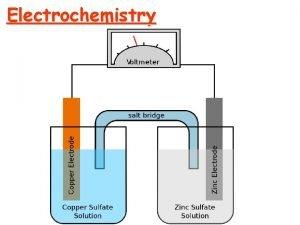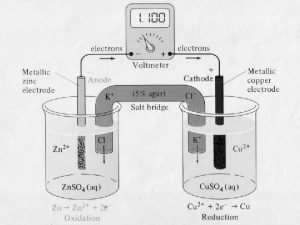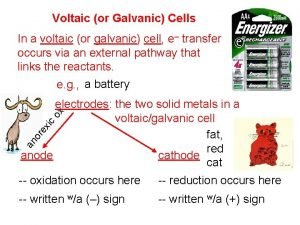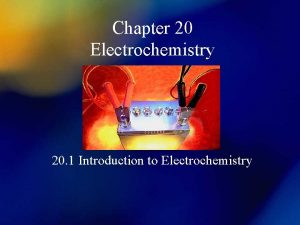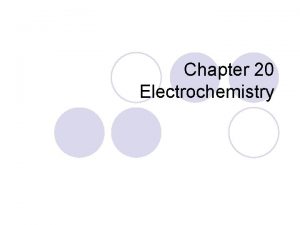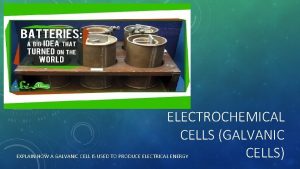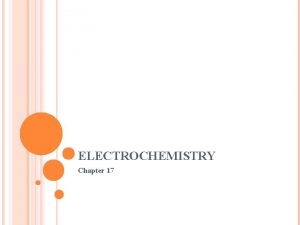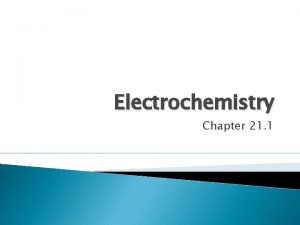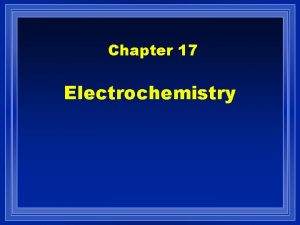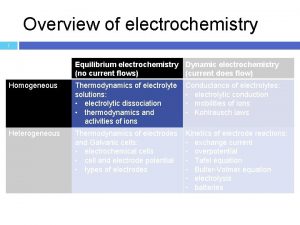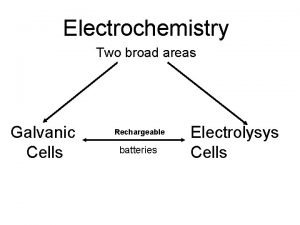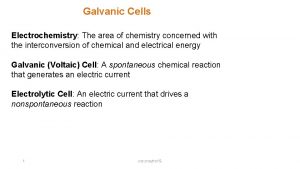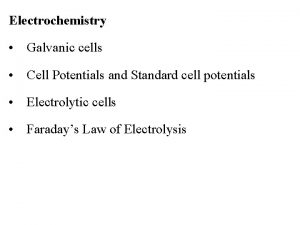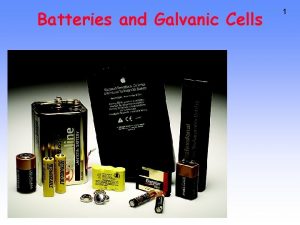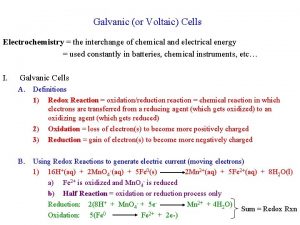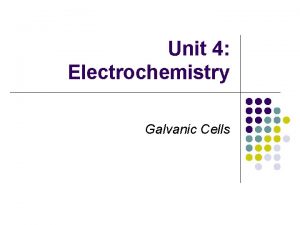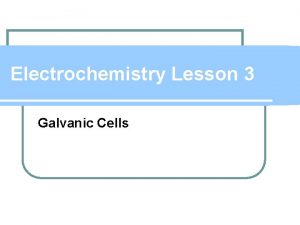Chapter 18 Electrochemistry Section 18 2 Galvanic Cells

















- Slides: 17

Chapter 18 Electrochemistry

Section 18. 2 Galvanic Cells Galvanic Cell § Device in which chemical energy is changed to electrical energy. § Uses a spontaneous redox reaction to produce a current that can be used to do work. Copyright © Cengage Learning. All rights reserved 2

Section 18. 2 Galvanic Cells A Galvanic Cell Copyright © Cengage Learning. All rights reserved 3

Section 18. 2 Galvanic Cells Galvanic Cell § Oxidation occurs at the anode. § Reduction occurs at the cathode. § Salt bridge or porous disk – devices that allow ions to flow without extensive mixing of the solutions. § Salt bridge – contains a strong electrolyte held in a Jello–like matrix. § Porous disk – contains tiny passages that allow hindered flow of ions. Copyright © Cengage Learning. All rights reserved 4

Section 18. 2 Galvanic Cells Cell Potential § A galvanic cell consists of an oxidizing agent in one compartment that pulls electrons through a wire from a reducing agent in the other compartment. § The “pull”, or driving force, on the electrons is called the cell potential ( ), or the electromotive force (emf) of the cell. § Unit of electrical potential is the volt (V). Ø 1 joule of work per coulomb of charge transferred. Copyright © Cengage Learning. All rights reserved 5

Section 18. 2 Galvanic Cells Voltaic Cell: Cathode Reaction To play movie you must be in Slide Show Mode PC Users: Please wait for content to load, then click to play Mac Users: CLICK HERE Copyright © Cengage Learning. All rights reserved 6

Section 18. 2 Galvanic Cells Voltaic Cell: Anode Reaction To play movie you must be in Slide Show Mode PC Users: Please wait for content to load, then click to play Mac Users: CLICK HERE Copyright © Cengage Learning. All rights reserved 7

Section 18. 3 Standard Reduction Potentials Galvanic Cell § § All half-reactions are given as reduction processes in standard tables. § Table 18. 1 § 1 M, 1 atm, 25°C When a half-reaction is reversed, the sign of E° is reversed. When a half-reaction is multiplied by an integer, E° remains the same. A galvanic cell runs spontaneously in the direction that gives a positive value for E°cell. Copyright © Cengage Learning. All rights reserved 8

Section 18. 3 Standard Reduction Potentials Example: Fe 3+(aq) + Cu(s) → Cu 2+(aq) + Fe 2+(aq) § § § Half-Reactions: § Fe 3+ + e– → Fe 2+ E° = 0. 77 V § Cu 2+ + 2 e– → Cu E° = 0. 34 V To balance the cell reaction and calculate the cell potential, we must reverse reaction 2. § Cu → Cu 2+ + 2 e– – E° = – 0. 34 V Each Cu atom produces two electrons but each Fe 3+ ion accepts only one electron, therefore reaction 1 must be multiplied by 2. § 2 Fe 3+ + 2 e– → 2 Fe 2+ E° = 0. 77 V Copyright © Cengage Learning. All rights reserved 9

Section 18. 3 Standard Reduction Potentials Overall Balanced Cell Reaction 2 Fe 3+ + 2 e– → 2 Fe 2+ E° = 0. 77 V (cathode) Cu → Cu 2+ + 2 e– – E° = – 0. 34 V (anode) § Balanced Cell Reaction: Cu + 2 Fe 3+ → Cu 2+ + 2 Fe 2+ § Cell Potential: E°cell = E°(cathode) – E°(anode) E°cell = 0. 77 V – 0. 34 V = 0. 43 V Copyright © Cengage Learning. All rights reserved 10

Section 18. 3 Standard Reduction Potentials CONCEPT CHECK! Order the following from strongest to weakest oxidizing agent and justify. Of those you cannot order, explain why. Fe Na F- Na+ Cl 2

Section 18. 3 Standard Reduction Potentials Line Notation Used to describe electrochemical cells. Anode components are listed on the left. Cathode components are listed on the right. Separated by double vertical lines which indicated salt bridge or porous disk. § The concentration of aqueous solutions should be specified in the notation when known. § Example: Mg(s)|Mg 2+(aq)||Al 3+(aq)|Al(s) § Mg → Mg 2+ + 2 e– (anode) § Al 3+ + 3 e– → Al (cathode) § § Copyright © Cengage Learning. All rights reserved 12

Section 18. 3 Standard Reduction Potentials Description of a Galvanic Cell § The cell potential (always positive for a galvanic cell where E°cell = E°(cathode) – E°(anode)) and the balanced cell reaction. § The direction of electron flow, obtained by inspecting the half–reactions and using the direction that gives a positive E°cell. Copyright © Cengage Learning. All rights reserved 13

Section 18. 3 Standard Reduction Potentials Description of a Galvanic Cell § Designation of the anode and cathode. § The nature of each electrode and the ions present in each compartment. A chemically inert conductor is required if none of the substances participating in the half–reaction is a conducting solid. Copyright © Cengage Learning. All rights reserved 14

Section 18. 3 Standard Reduction Potentials CONCEPT CHECK! Sketch a cell using the following solutions and electrodes. Include: § The potential of the cell § The direction of electron flow § Labels on the anode and the cathode a) Ag electrode in 1. 0 M Ag+(aq) and Cu electrode in 1. 0 M Cu 2+(aq) Copyright © Cengage Learning. All rights reserved 15

Section 18. 3 Standard Reduction Potentials CONCEPT CHECK! Sketch a cell using the following solutions and electrodes. Include: § The potential of the cell § The direction of electron flow § Labels on the anode and the cathode b) Zn electrode in 1. 0 M Zn 2+(aq) and Cu electrode in 1. 0 M Cu 2+(aq) Copyright © Cengage Learning. All rights reserved 16

Section 18. 3 Standard Reduction Potentials CONCEPT CHECK! Consider the cell from part b. What would happen to the potential if you increase the [Cu 2+]? Explain. Copyright © Cengage Learning. All rights reserved 17
 Galvanic cell khan academy
Galvanic cell khan academy Electrochemistry
Electrochemistry Redox half reactions
Redox half reactions Leclanche cell anode and cathode reactions
Leclanche cell anode and cathode reactions Why are galvanic cells spontaneous
Why are galvanic cells spontaneous Voltaic and galvanic cells
Voltaic and galvanic cells Nondisjunction in meiosis
Nondisjunction in meiosis Ap chemistry chapter 18 electrochemistry test
Ap chemistry chapter 18 electrochemistry test Intro to electrochemistry
Intro to electrochemistry Chapter 20 review electrochemistry
Chapter 20 review electrochemistry Chapter 21 electrochemistry
Chapter 21 electrochemistry Electrolysis vs voltaic cell
Electrolysis vs voltaic cell Chapter 20 electrochemistry
Chapter 20 electrochemistry Paranasal sinuses development
Paranasal sinuses development Reabsorption
Reabsorption Thyroid gland
Thyroid gland How are mitosis and meiosis similar
How are mitosis and meiosis similar Somatic vs germ cells
Somatic vs germ cells

